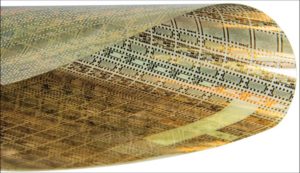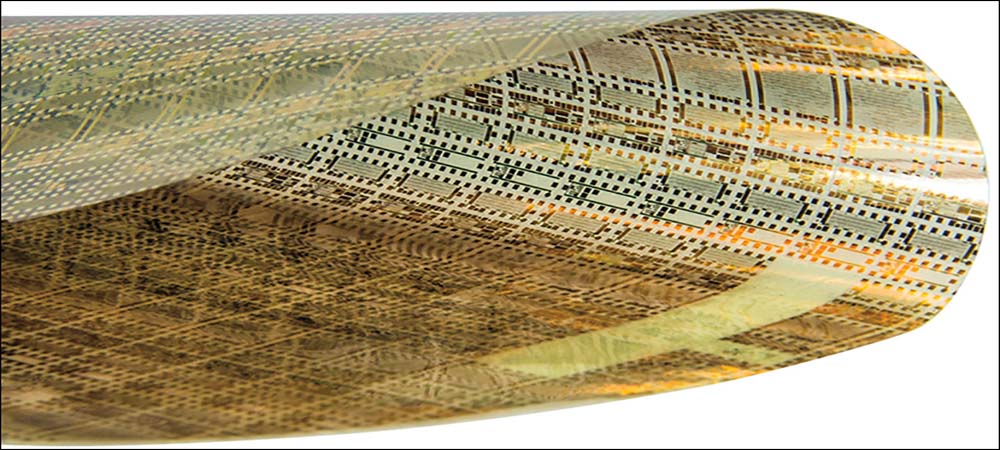Several drug companies have been applying Near Field Communication (NFC) and radio frequency identification (RFID) tags to products in order to improve supply chain visibility, as well as enable authentication and tamper detection, but the deployments come with a cost. Dedicated RFID readers are required for UHF RFID tags, and both NFC and UHF RFID labels can be expensive, as well as challenging to apply to very small products with curved surfaces. Flexible electronics company PragmatIC Semiconductor, inlay manufacturer Avery Dennison and pharmaceutical packaging company Schreiner MediPharm have teamed up to provide what they say is a low-cost solution: an NFC-enabled label for medications.
The new label is intended to be slim and flexible, the companies reports, so that it can be easily applied, encoded and read, even on a small glass vial, syringe or pill bottle. PragmatIC’s ultra-thin FlexIC 13.56 MHz chip, compliant with a subset of the ISO 14443 standard, is being built into Avery Dennison’s inlay and then incorporated into Schreiner MediPharm’s labels for use on cartons, vials and syringes. The solution will provide NFC-enabled smart labels for monitoring healthcare products and medications, with the aim of improving patient safety by identifying any incidence of tampering, proving authenticity, and offering patients reordering information and instructions.

PragmatIC’s FlexIC chip is being built into Avery Dennison’s inlays and then incorporated into Schreiner MediPharm’s labels.
The companies announced the smart label release in December 2020. The solution includes flexible NFC ICs from PragmatIC, a U.K.-based electronics provider. FlexICs are thinner than a human hair, the company reports, and are suitable for small-diameter objects such as syringes or vials, since they can bend when applied to curved surfaces. Avery Dennison’s inlays with FlexIC chips have been adopted by Schreiner MediPharm, a German company that develops and produces specialty labels and self-adhesive marking solutions for the pharmaceutical and medical device industries.
Schreiner MediPharm has been in conversations with its customers for several years regarding the use of NFC technology to better authenticate and manage medications, says Stefan Wiedemann, the firm’s senior director of strategic marketing and business development. Part of the interest is in authentication, as rising numbers of counterfeit drugs have entered the pharmaceutical market. “The topic of drug integrity is also something being discussed more, and more,” Wiedemann states.
NFC technology enables tamper-evident functionality as well, allowing users to verify that products have not been accessed or opened. Additionally, Wiedemann reports, patients can benefit from the ability of an NFC-equipped drug container since the RFID interface offers easy access to additional content about a particular drug. For instance, printed labels on medicines can be difficult to read for some patients. Drug use can be confusing, he explains, and managing dosage and remembering when a product was last taken poses another challenge that NFC technology can help to address.
NFC offers a solution, Wiedemann explains, by enabling content to be viewed in a chosen format on a user’s phone when he or she taps the tag. “In principle,” he notes, “NFC labels require drugs or use cases that are able to bear the additional investment.” Previously, NFC labels have often been provided for high-value products, or for those at high risk of misuse or counterfeiting. That is due to the cost of traditional NFC inlays and chips, Wiedemann explains. Schreiner MediPharm, PragmatIC and Avery Dennison have, therefore, built a label that they intend companies to apply at a lower cost for everyday healthcare and pharmaceutical products.
The flexible tag is less expensive to manufacture, Wiedemann says, in part because it does not require the silicon that is needed for traditional tag chips. Thus, it can bend with the curved surfaces of vials or other items. Traditionally, he says, “If you wanted to apply a regular NFC chip, there is a risk of damaging the chip during labelling or transport, and the chip needed additional protection.” Schreiner MediPharm has been conversing with drug companies regarding the use of NFC for several years, he adds, but until recently, the focus was on investigating appropriate use cases for which the technology could offer the greatest value.
The pharmaceutical sector’s interest in NFC has increased significantly in recent times, Wiedemann says, partly due to the benefits the technology could offer in combating counterfeits, and because it can provide content to physicians and patients. “What we see now is more and more companies are prepared to invest and use NFC technology in the market,” he states. In some cases, companies may employ a hybrid approach, with UHF RFID being used on some products to capture supply chain data with dedicated RFID readers, and with NFC tags on products that can be read via smartphones.
PragmatIC provides the FlexIC chips at a cost lower than that of some standard NFC chips, according to Alastair Hanlon, the company’s chief commercial officer. Unlike traditional chips, he explains, the FlexIC is made of plastic rather than silicon, and it is so thin it can be wrapped around a curved surface, such as a vial of medication or vaccine. The FlexICs are designed to be thin and bendable in order to enable a single antenna layer, he notes, and they can be attached to paper or plastic inlays.
The labels employ an inlay with secure encoding functionality and converting services, which are provided by Avery Dennison. “We’re able to bring our NFC product design and manufacturing knowledge to the table,” says Amir Khoshniyati, Avery Dennison’s head of NFC business. In fact, the company has customers using its NFC and RFID products in a variety of industries. “We’ve seen an uptick in the healthcare and pharma space,” he adds, as well as in consumer packaged goods.
According to Wiedemann, the labels will commonly be used for multiple purposes. Beyond authentication is tamper detection. This function can be created by causing the tag’s destruction if a product is opened, as long as the tag is affixed over the product’s lid. The technology also enables users to confirm that an item has not been tampered with. For patients, the tags could provide value after they take a product home. For instance, they could tap the NFC tag with their smartphone to view a medication’s name, expiration data and dosage information, and to access instructions for how the drug should be taken.
In addition, pharmaceutical companies could link videos or other content to an NFC label’s unique ID number. When a user taps his or her phone against the tag, that person could then access a video that might show, for example, how to use an inhaler or inject a diabetes medication. If the patient chose to tap the phone each time she or he took a medicine, that information could be stored in order to confirm the individual was using the drug properly, and that no doses were missed.
A consumer could utilize the labels with an application that would ask such questions as “Did I take my medication today?” Another typical use case could be what Wiedemann calls a key-lock system, by which a device should recognize the medication inserted into it before that drug is administered. For instance, a reusable insulin pen could come with its own NFC reader that would be able to identify and verify a tagged insulin cartridge according to the therapeutic recommendation.
The release is currently in phase one, Khoshniyati says, with labels being provided to select customers throughout the first half of 2021. Avery Dennison plans to release a broader portfolio set of inlays that Schreiner MediPharm can build into labels, he adds. The controlled release means companies will be launching the new labels in limited ways, with plans for full production later this year. “That brings a level of assurance to the market that it will be provided in an affordable and competent way,” he states.


